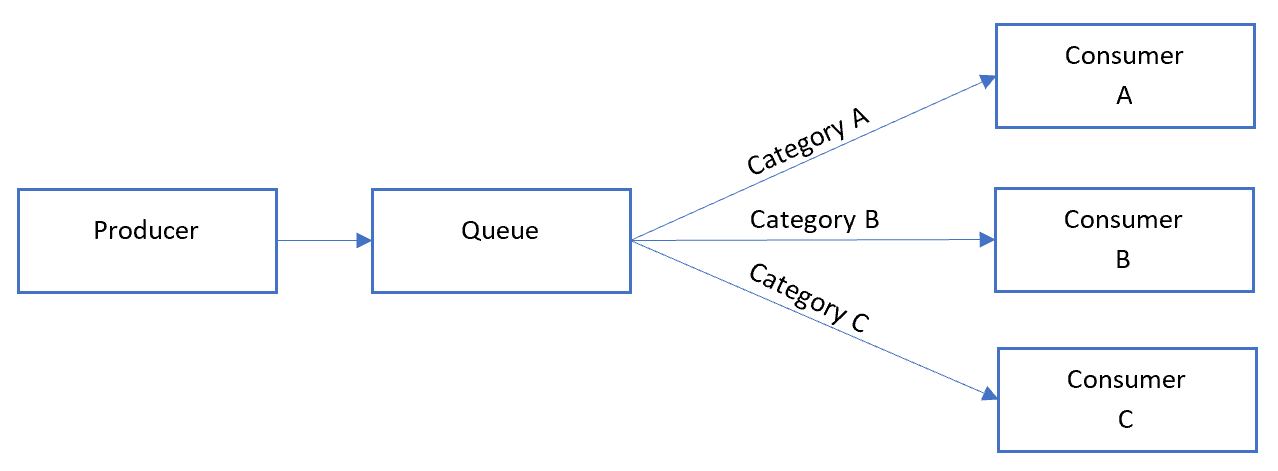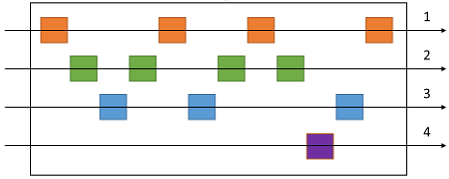Process a set of related messages in a defined order, without blocking processing of other groups of messages.
Context and problem
Applications often need to process a sequence of messages in the order they arrive, while still being able to scale out to handle increased load. In a distributed architecture, processing these messages in order is not straightforward, because the workers can scale independently and often pull messages independently, using a Competing Consumers pattern.
For example, an order tracking system receives a ledger containing orders and the relevant operations on those orders. These operations could be to create an order, add a transaction to the order, modify a past transaction, or delete an order. In this system, operations must be performed in a first-in-first-out (FIFO) manner, but only at the order level. However, the initial queue receives a ledger containing transactions for many orders, which may be interleaved.
Solution
Push related messages into categories within the queuing system, and have the queue listeners lock and pull only from one category, one message at a time.
Here's what the general Sequential Convoy pattern looks like:

In the queue, messages for different categories may be interleaved, as shown in the following diagram:

Issues and considerations
Consider the following points when deciding how to implement this pattern:
- Category/scale unit. What property of your incoming messages can you scale out on? In the order tracking scenario, this property is the order ID.
- Throughput. What is your target message throughput? If it is very high, you may need to reconsider your FIFO requirements. For example, can you enforce a start/end message, sort by time, then send a batch for processing?
- Service capabilities. Does your choice of message bus allow for one-at-a-time processing of messages within a queue or category of a queue?
- Evolvability. How will you add a new category of message to the system? For example, suppose the ledger system described above is specific one customer. If you needed to onboard a new customer, could you have a set of ledger processors that distribute work per customer ID?
- It's possible that consumers might receive a message out of order, due to variable network latency when sending messages. Consider using sequence numbers to verify ordering. You might also include a special "end of sequence" flag in the last message of a transaction. Stream processing technologies such as Spark or Azure Stream Analytics can process messages in order within a time window.
When to use this pattern
Use this pattern when:
- You have messages that arrive in order and must be processed in the same order.
- Arriving messages are or can be "categorized" in such a way that the category becomes a unit of scale for the system.
This pattern might not be suitable for:
- Extremely high throughput scenarios (millions of messages/minute or second), as the FIFO requirement limits the scaling that can be done by the system.
Workload design
An architect should evaluate how the Sequential Convoy pattern can be used in their workload's design to address the goals and principles covered in the Azure Well-Architected Framework pillars. For example:
| Pillar | How this pattern supports pillar goals |
|---|---|
| Reliability design decisions help your workload become resilient to malfunction and to ensure that it recovers to a fully functioning state after a failure occurs. | This pattern can eliminate race conditions that are hard to troubleshoot, contentious message handling, or other workarounds for addressing incorrectly ordered messages that can lead to malfunctions. - RE:02 Critical flows - RE:07 Background jobs |
As with any design decision, consider any tradeoffs against the goals of the other pillars that might be introduced with this pattern.
Example
On Azure, this pattern can be implemented using Azure Service Bus message sessions. For the consumers, you can use either Logic Apps with the Service Bus peek-lock connector or Azure Functions with the Service Bus trigger.
For the previous order-tracking example, process each ledger message in the order it's received, and send each transaction to another queue where the category is set to the order ID. A transaction will never span multiple orders in this scenario, so consumers process each category in parallel but FIFO within the category.
The ledge processor fan outs the messages by de-batching the content of each message in the first queue:

The ledger processor takes care of:
- Walking the ledger one transaction at a time.
- Setting the session ID of the message to match the order ID.
- Sending each ledger transaction to a secondary queue with the session ID set to the order ID.
The consumers listen to the secondary queue where they process all messages with matching order IDs in order from the queue. Consumers use peek-lock mode.
When considering scalability, the ledger queue is a primary bottleneck. Different transactions posted to the ledger could reference the same order ID. However, messages can fan out after the ledger to the number of orders in a serverless environment.
Next steps
The following information may be relevant when implementing this pattern: